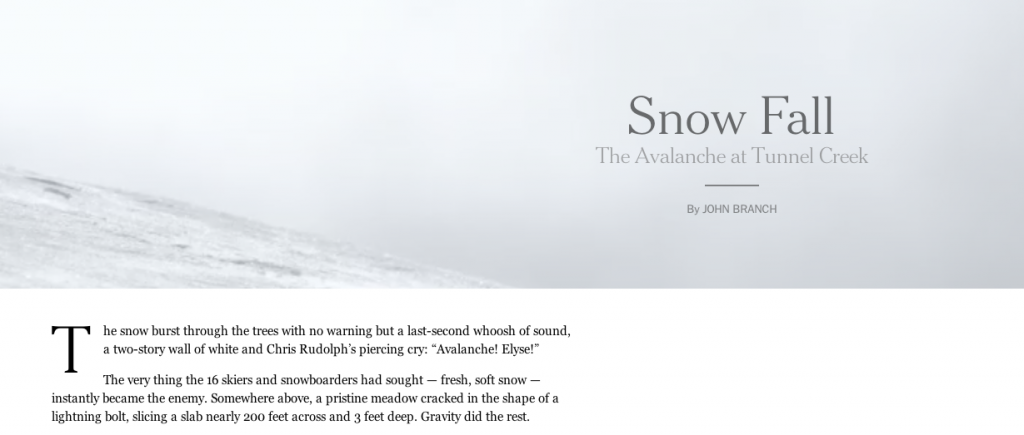At this point in my process, I’m tentatively identifying my project as an interactive documentary. Will I continue to label it as such? Not sure. For now, I want to use the question, Why Interactive?, as an invitation (or demand) to constantly reflect on what interaction means to me and how it fits into my own methods for telling/sharing/collaborating on stories with others.
Recently, I was talking with STA about storytelling and documentaries. He doesn’t like interactive documentaries because he sees the interactive features as often tacked on and unnecessary and, as he bluntly put it, “in documentaries someone is telling a story, and they should tell it, not make me do it!” His reasoning got me thinking.
superficial and superfluous
I did a little research on how “interactivity,” “interactive documentary” and “interactive storytelling” gets used and came across the article, 20 Beautiful examples of “Snowfall” style interactive storytelling. In it the author describes the interactive storytelling found in the recent NY Times story Snow Fall as a “technique for presenting longform writing online, by embellishing it with integrated multimedia elements, gorgeous photography, infographics and so on.” The key word here is embellish. To add to or enhance. But not necessarily to transform, to make more meaningful, or to allow users/readers to interact with on deeper levels.
In their critique of the “Snow Fall” phenomenon, known as snowfalling, Bobbie Johnson suggests that these new multimedia techniques are just about “razzle-dazzle,” often distracting the reader from the story instead of inviting them to pay attention to and remember it. Johnson’s critique is a caution against using new, trendy techniques that compromise the integrity of the longform story. The focus, Johnson argues, should always be on the story and the reader who wants to deeply engage with it.
I like this idea of thinking about how to focus audiences on engaging with and paying attention to the story, not the flashy graphics or dazzling parallax techniques. But, in my thinking about the dangers of superficial interactivity, I want to take a slightly different approach. My different approach is partly because I don’t envision my interactive documentary as journalism, which seems to be the focus of these articles and the discussion of longform stories.
While Johnson is invested in longform stories and how new multimedia techniques may or may not distract/detract from their ability to communicate a compelling story, I’m interested in exploring how multimedia techniques might enable us to transform how we tell stories. What new forms of storytelling might come out of our experiments with digital (and visual, aural) storytelling? Besides long form stories, how can we tell stories that enable users to think deeply, to engage, to care about, and to participate in the ideas and experiences we are sharing? And how can we use new media to do so?
I see interactive storytelling and interactive documentaries as superficial and superfluous when they tell the same (bad/boring?) story, just with video or pretty images. Like here. When they don’t challenge, resist, transform or play with linear methods that offer only a beginning, middle and end and that involve author-as-producer and user-as-passive-consumer.
busting the binary: production/consumption
Unlike STA, who wants a documentary to tell him a story, not invite him to participate in the crafting of that story, I like the idea of storytelling not as reporting or telling, but as collaborating and initiating a conversation with a wide range of others. I want users to engage with, pay attention to and participate in the process of making meaning out of the stories that I tell and the accounts that I give. This interest in collaboration, conversations and in challenging the binary of author/artist-as-producer and user-as-consumer/listener, is heavily influenced by my training in feminist pedagogy and my investment in making and staying trouble. I’ll say more about those influences in a future post.
in summary (for me):
- interactivity is used to try telling stories in new, non-linear ways
- interactivity is used to challenge/disrupt/play with the strict division between Storyteller and story listeners
- interactivity is about encouraging users to engage, participate, pay attention, care, resist, interrupt stories



